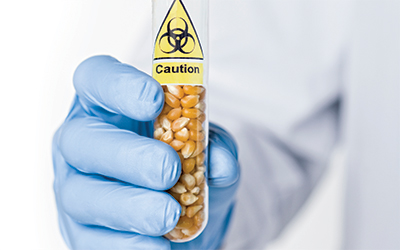American foodies are a sophisticated and discerning bunch. We frequent farmers’ markets, scrutinize food labels and proselytize about the evils of high-fructose corn syrup. So, how did we wind up giving genetically modified foods a pass?
In the past two decades, genetically modified organisms (GMOs) have completely infiltrated our farm fields, grocery stores and kitchens — so much so that most people can’t say with any certainty how many GMOs they actually consume daily. If you eat corn chips, cook with canola oil, drink soymilk, or indulge in the occasional muffin made with baking powder, for instance, chances are you’re eating GMOs.
Twenty-five years ago, plant genetics was an obscure science and far from the center of the food chain. Today, more than 54 percent of American crops contain GMOs and roughly 70 percent of processed foods harbor at least one genetically modified ingredient, according to the Center for Science in the Public Interest, a nonprofit education and advocacy organization.
Not surprisingly, a lot of money is at stake. Monsanto, team-GMO’s biggest player, reported $13.5 billion in sales last year, up 14 percent from the year before. The sales figures are easy to track and enumerate. Far less certain is the impact that GMOs are having on our health.
The fear, among many health experts, is that GMOs are fueling an increase in food allergies and other gut-based ills. Although a direct correlation is impossible to track in the United States because GMO foods are not labeled, a glance across the Atlantic is edifying.
British researchers found a 50 percent jump in soy allergies after the introduction of GMO soy into the country’s food chain. Consequently, the European Union banned genetically modified foods in 1999. The moratorium was lifted in 2004, when strict labeling requirements went into effect.
In the United States, GMO proliferation has corresponded with upticks in irritable bowel syndrome (IBS), Crohn’s disease, leaky gut, and, especially in children, allergies. Coincidence? Perhaps, but Don Huber, PhD, professor emeritus of plant pathology at Purdue University in West Lafayette, Ind., doesn’t think so. The introduction of GMOs into the food supply, says Huber, has been not only a massive human experiment, but a large-scale “betrayal of the public trust.”
Confusion Breeds Ignorance
One reason so many Americans are unclear about the relative merits and risks of GMOs is that the science behind them is notoriously challenging to grasp — and easy to spin.
A genetically modified organism is one in which the genetic composition of that organism has been altered — meaning that specific elements of the DNA have been removed or added to achieve certain ostensibly desirable traits.
In agriculture, the process is used to create so-called super-plants that can withstand things like insect attack and drought, or that possess flavor and texture profiles that make them more appealing. Those who defend the practice argue that the technology is simply a 21st-century approach to plant breeding, and that farmers have long bred plant species for desirable traits, such as better flavor and texture or greater yield.
Critics of GMOs point out that there are a number of flaws inherent in this breeding analogy. For starters, they say, genetic modification allows the transfer of any gene across any species in ways that traditional farmers never imagined. Plants and organisms unable to physically reproduce can become unnaturally intertwined. A novel gene may be cobbled together from a plant virus, a soil bacterium and a petunia plant, for example — creating a kind of botanical Frankenstein.
Genetic plant modifications are also unwieldy and imprecise. “Genetic engineering takes artificial combinations of genes that have never existed together, forcibly inserts them into random locations in the host genome and then clones the results,” says Jeffrey Smith, executive director of the Institute for Responsible Technology and author of Genetic Roulette: The Documented Health Risks of Genetically Engineered Foods.
In essence, people who make GMOs are the same people who test GMOs for safety.
What’s most concerning to the critics is that, in 1992, the Food and Drug Administration (FDA) relegated responsibility for the safety of GMO foods to industry. The companies themselves not only decide whether or not to consult with federal agencies, but also what scientific data to submit. In essence, people who make GMOs are the same people who test GMOs for safety, says Bruce Blumberg, PhD, a developmental and cell biologist at the University of California, Irvine. “Americans think the FDA and EPA are testing GMOs and making them safe, but that’s simply not true.”
Advances in GMOs accelerated under the loose regulations. The first genetically engineered food hit the market in 1994 (the Flavr Savr tomato). Since then, sugar beets, potatoes, corn, squash, rice, soybeans, vegetable oils and animal feed have all been manipulated. In 2011, American farmers planted more than 170 million acres of GMO crops. There’s even a genetically engineered salmon in the works.
GMO Health Hazards
So, what does this mean for you? Honestly, no one knows for sure. Scientists can’t measure the impact of GMOs on human health when no one knows which foods contain GMOs and which don’t. Likewise, companies are not required to share their health and safety research. The secrecy has fueled a hostile climate between GMO supporters and detractors.
“When there are so few studies done on the safety of GMOs in people, we have to act like detectives. We have to weigh anecdotal evidence, case studies and theoretical dangers to build our case. Put it all together,” says Smith, “and even from the most conservative viewpoint there is a stunning implication of harm.”
“When there are so few studies done on the safety of GMOs in people, we have to act like detectives. We have to weigh anecdotal evidence, case studies and theoretical dangers to build our case.”
Until recently, genes were thought of like Legos. Plant scientists imagined they could snap unwanted genes out and snap desired genes in without having an impact on the surrounding DNA. But that tidy theory was upended when the Human Genome Project discovered that genes don’t work in isolation but as part of a system.
The current understanding is that inserting new genes into a plant’s DNA can create untold collateral damage, says Jeffrey Bland, PhD, FACN, a nutritional biochemist and president of the Personalized Lifestyle Medical Institute in Seattle. “What other effects might genetic modification be having in humans that we don’t know about?” he says.
Here are a few of the top concerns:
1) Leaky Gut
Leaky gut syndrome takes place when fissures open between cells lining the gastrointestinal (GI) tract. Partially digested food particles ooze through those fissures into the body and appear to be foreign invaders. The immune system is then called out to seek and destroy. If the situation isn’t ameliorated, autoimmune disorders, food allergies and food sensitivities may arise. GMOs introduce gene sequences that the body has never seen before. The concern, says Smith, is that our immune systems may be “interpreting the GMO as a harmful attacker and responding in kind.”
Consider the Bacillus thuringiensis (Bt) toxin, which is one of the most common genetically engineered traits. GMO crops that contain the Bt toxin are designed to kill insects by breaking open their stomachs. The concern now is that it might be causing a related reaction in humans.
“The gut is the first interaction point between GMOs and human physiology — it’s on the front line,” says Bland.
When scientists raised specific concerns about genetically modified corn, Monsanto and the Environmental Protection Agency offered assurances that the crop would affect only the digestive tracts of insects. They promised that the human digestive tract would destroy the Bt toxin. But a 2011 study of pregnant women in Quebec, Canada, found Monsanto’s Bt toxin in the blood of 93 percent of the women tested and in 80 percent of the umbilical-cord blood of their babies. The authors suspect the Bt toxin migrated from the genetically engineered corn, ubiquitous in processed foods, and entered the women’s blood supply, something Monsanto said could never happen.
2) Allergic Reactions
Allergies are a growing health problem, especially for kids. Between 1997 and 2007, food allergies in children rose nearly 20 percent. Most food allergies are reactions to proteins, such as milk, eggs, soy, nuts and gluten. And since most genetically engineered crops make new proteins, it’s conceivable that they could spark new allergies or increase the incidence or severity of existing allergic reactions.
In the mid-’90s, plant scientists inserted a Brazil-nut gene into soy DNA to make a soybean with more diverse proteins. Nuts are some of the most common and most deadly food allergens. Luckily, before the new soybean went to market, the creators tested it for allergenic properties. To their surprise, the new soybean carried the nut’s allergenic gene. That was a close call, but Smith worries it will not be the last. When a new protein is introduced to the food supply, he notes, it is difficult to know whether it will cause an allergic reaction because people typically don’t show symptoms until they’ve had several exposures.
The World Health Organization (WHO) designed a safety net to lower the odds of another Brazil-nut incident. At its core is a database that allows crop developers to compare the structure of any new protein with the structure of proteins that are known allergens. WHO also recommends testing new proteins for digestive and heat stability. (The more stable a protein is during digestion and under heat, the longer it spends in the gut and the higher the odds it will cause an allergic reaction.)
According to Smith, genetically modified soy, corn and papaya all failed parts of WHO’s voluntary tests. Specifically, he notes, a protein in Bt-toxin corn is similar to a protein that triggers egg-yolk allergies. Likewise, a protein in the widely used Roundup Ready soybean aligns closely with a dust-mite allergen. The biochemical result, says Smith, is that “if you have an allergic response to dust mites, you might also have an allergic response to Roundup Ready soy.”
More troubling still is a study showing that part of the Roundup Ready gene from soy can transfer into the DNA of human intestinal bacteria, where it may continue to be biologically active. That means “that these proteins may reproduce inside your gut,” says Smith, “so, if you are allergic to that protein, and it is being constantly made within your GI tract, you will constantly be triggered [to have allergic reactions].”
3) Endocrine Disruption
Ninety percent of plants genetically modified to survive herbicides contain residues of Roundup. The active ingredient in Roundup, glyphosate, disrupts the endocrine system, which is in charge of secreting hormones that regulate our moods, our metabolism and our sexual functioning.
In laboratory studies of human cells, glyphosate disrupted hormone systems and led to cell death. In animal studies, glyphosate upset hormonal balance and led to infertility and birth defects.
Biotechnology companies insist the products are safe. But Monsanto said the same thing about bovine growth hormone in the 1990s, which has since been linked to a possible increased risk of cancer.
The real challenge, say GMO critics, is that industry-funded safety studies typically last only 90 days, which is too short to determine whether lab animals will develop any chronic or life-threatening illness.
The real challenge, say GMO critics, is that industry-funded safety studies typically last only 90 days, which is too short to determine whether lab animals will develop any chronic or life-threatening illness.
Case in point: Scientists in France recently conducted feeding tests in rats over a period of two years. They fed the animals GMO corn sprayed with Roundup or gave them Roundup-spiked water (at levels considered safe in the United States). The rats exposed to Roundup, especially females, developed alarming, widespread tumors. The results, published in the journal Food and Chemical Toxicology, were controversial and lambasted by pro-GMO experts who called the data flawed and the author biased.
Smith offers a counterpoint for each objection. Critics say the scientists used tumor-prone rats; Smith says they were the same type of rats Monsanto used in its studies. Critics say the study population was too small; Smith points out that Monsanto used the same number of rats when testing for safety and efficacy. This leads Smith to characterize such protests as “a desperate, unscientific attempt to distort and deny damning evidence” that could be used to ban GMOs.
To be clear, there is no direct evidence that GMOs harm people. All experts can do is connect the dots and speculate. That’s because it is both highly unethical and nearly impossible to conduct randomized controlled feeding studies on people. Plus, since virtually everyone is already eating some quantity of GMO-laced foods, finding a control group is impractical. (Even organic foods can be subject to GMO contamination due to wind or insect-related cross-pollination.)
Interestingly, however, unscientific feeding studies are happening on farms around the country. Livestock eat either GMO-laced feed or non-GMO feed. What studies and anecdotal evidence show again and again is that animals fed genetically modified feed develop major health problems, including lowered fertility, weakened immune systems and an increase in stomach troubles.
“Hundreds of people tell us that when they switched to [predominantly] non-GMO diets, their health improved along the same lines we see in animals who are taken off GMO feed.”
Coincidentally (or perhaps not), the list of ailments syncs with anecdotal evidence of what some experts see in people. “Hundreds of people tell us that when they switched to [predominantly] non-GMO diets, their health improved along the same lines we see in animals who are taken off GMO feed. [But] no one is looking for evidence of harm,” Smith says, “because the entire fortune of the industry is at stake.”
Unfortunately, as with many high-stakes debates, the conversation about GMOs has deteriorated into a shouting match between passionate extremes. Currently, there is no certain “right” or “wrong” side. There is only initial evidence and theory — and a growing consumer hunger for more-conclusive research. Because when it comes to human health, Smith acknowledges, “we have too few data points to draw firm conclusions about specific disease.” What we do have, he says, is “sufficient theoretical understanding and evidence to warrant great concerns.”
4 Ways to Say No to GMOs
At some point, unless science finds a way to sort the safety issues, consumer resistance will likely persuade food companies to label GMO products sold in the United States, just as they’ve done in Europe. In the meantime, the industry will start seeing GMO ingredients as a liability, predicts Jeffrey Smith, executive director of the Institute for Responsible Technology and author of Genetic Roulette: The Documented Health Risks of Genetically Engineered Foods. Here are a few ways to avoid GMOs:
- Buy organic. To be certified “organic” under USDA guidelines, foods cannot contain compounds from genetically engineered crops. (Be aware that cross-contamination can occur due to wind or insects.)
- Look for Non-GMO Project seals. The Non-GMO Project is a nonprofit organization dedicated to clearly labeling and independently verifying foods that don’t contain GMO ingredients.
- Avoid non-organic foods likely to be made with GMOs, including products containing corn, soy, canola, cottonseed and sugar beets, as well as some produce, like papaya from China or Hawaii, and zucchini and yellow squash. Most sugar, if not organic, is probably a combination of both sugar cane and genetically modified sugar beets.
- Get involved. The GMO-labeling issue is (most likely) coming to a ballot near you. California’s 2012 ballot initiative lost by a slim margin last year, but that doesn’t mean the issue is going away. “There are anti-GMO organizations in at least 30 states focused on getting legislation on the ballot for the 2013 election cycle,” says Smith. “We’ve never seen this level of awareness and concern in the United States.” Both concern and consternation about GMOs are running at all-time highs. If you want to get involved, you can join the Institute for Responsible Technology’s Tipping Point, a network of local activists working to educate their communities on the dangers of GMOs. (Go to www.responsibletechnology.org.)





This Post Has 0 Comments